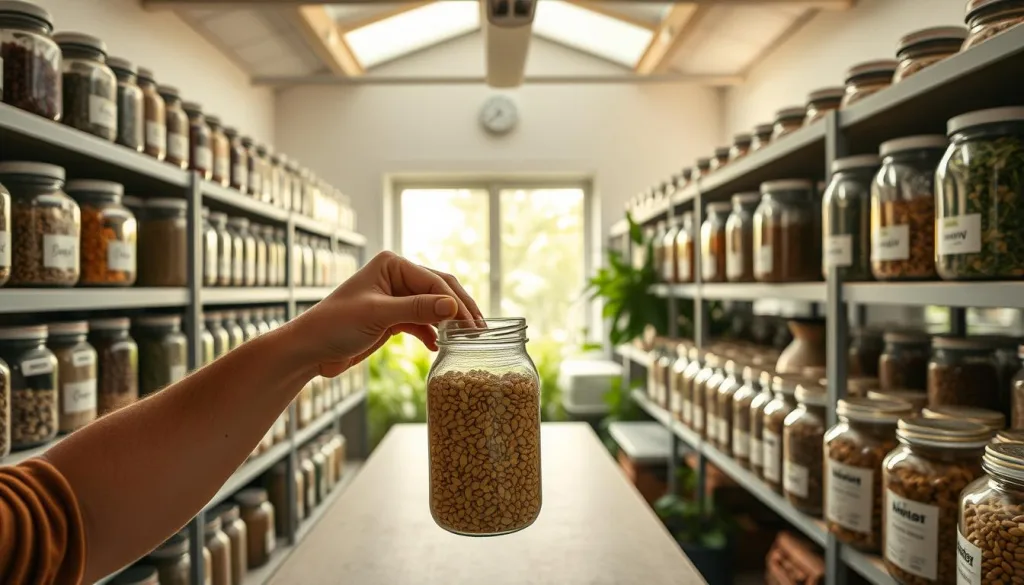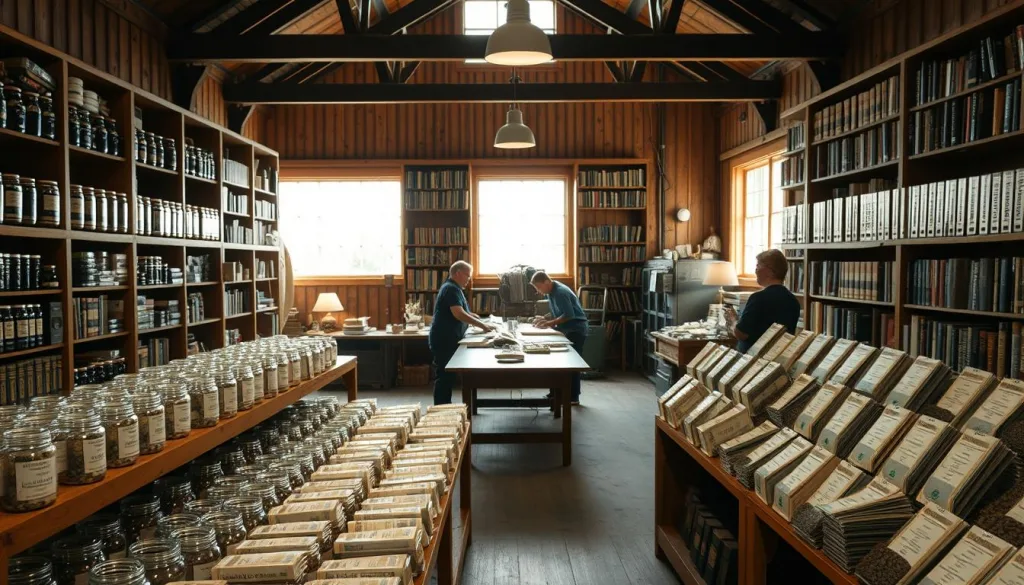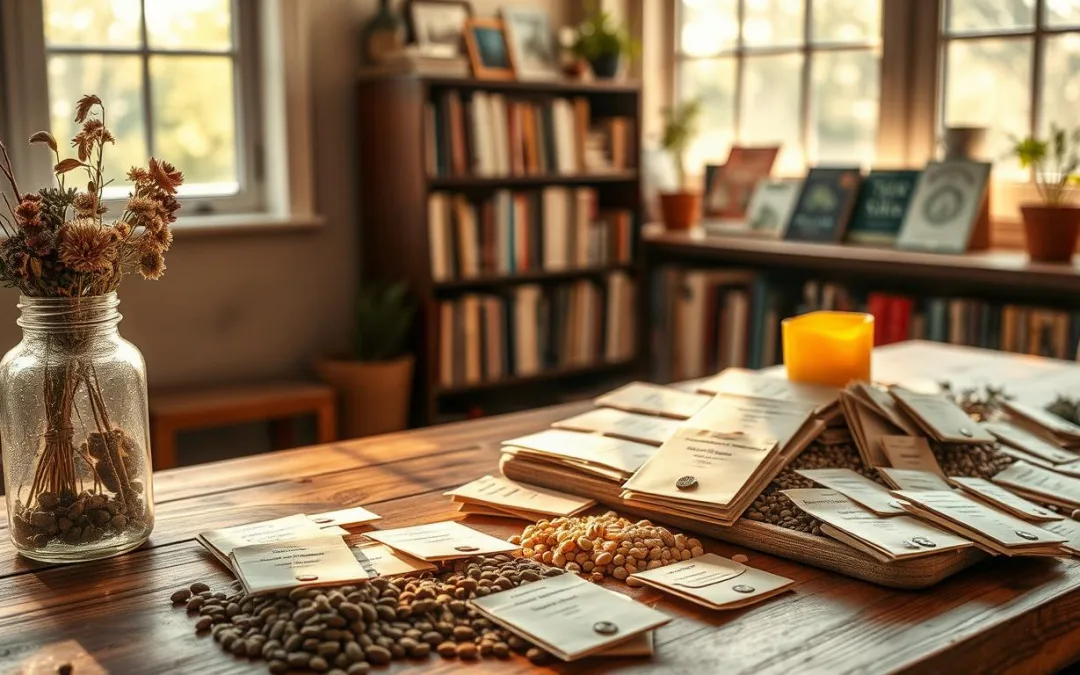Seed saving connects gardeners to their agricultural roots. It’s more than just growing plants—it’s about keeping food systems alive. By saving seeds, gardeners help crops adapt to their local environment.
Seed saving is a careful process. It involves picking the best plants and saving their seeds. This way, gardeners keep heirloom seeds alive, helping to save biodiversity.
Seed saving is more than just saving seeds. It lets growers control their food, cut down on commercial seed costs, and grow plants that fit their area perfectly.
Key Takeaways
- Seed saving preserves agricultural genetic diversity
- Heirloom seeds represent plant varieties over 50 years old
- Proper seed collection ensures future crop sustainability
- Gardeners can reduce seed purchasing costs through saving
- Local adaptation improves plant resilience
Understanding the Importance of Seed Preservation
Seed preservation is more than a gardening trick. It’s key to keeping our food supply safe and our farming practices green. Saving seeds helps us keep our food traditions alive.
Genetic diversity is vital for strong farms. It lets farmers grow crops that can handle tough weather, fight off diseases, and grow well in different places.
The Role of Genetic Diversity
Open-pollinated seeds are full of genetic variety. They let plants change and grow over time. Unlike other seeds, they keep the special traits of their parents.
- Enhance crop resilience
- Promote adaptation to local environments
- Maintain genetic complexity
Benefits of Heritage Varieties
Heirloom seeds tell stories of farming pasts. They’ve been around for at least 50 years. They have unique tastes, looks, and meanings that commercial seeds often don’t.
Economic Advantages of Seed Saving
Seed saving saves money for farmers and gardeners. It lets them grow plants that fit their land perfectly. This way, they don’t have to buy expensive seeds.
- Reduce seed purchasing costs
- Develop region-specific plant varieties
- Support local agricultural biodiversity
Keeping seeds for planting is a big step towards farming freedom and caring for our planet.
The Art of Seed Saving for Future Harvests
Seed saving has been around for over 10,000 years. It’s a key skill for gardeners and farmers who want to keep genetic diversity alive. Saving seeds for future harvests needs careful selection, precise techniques, and planning.
When you start saving seeds, you need to know about different plants. Some important things to think about are:
- Selecting healthy, mature plants with desirable traits
- Understanding pollination methods
- Timing the seed harvest correctly
- Implementing proper drying and storage techniques
Different plants need different approaches. Annual plants like lettuce and tomatoes grow and produce seeds in one year. This makes saving their seeds easy. But, perennial plants, which live longer and produce seeds every year, need more complex harvesting.
| Plant Type | Seed Collection Complexity | Recommended Storage Method |
|---|---|---|
| Annual Plants | Low | Airtight containers |
| Perennial Plants | High | Cool, dry environment |
| Cross-Pollinated Plants | Medium | Sealed glass jars |
Keeping seeds in the right conditions is key. This means keeping temperatures between 32°F and 50°F, humidity below 50%, and making sure seeds are dry. A simple bend v. snap test can check if seeds are dry enough for long-term storage.
Seed saving is not just a technique—it’s a commitment to preserving agricultural heritage and genetic diversity.
Selecting the Right Plants for Seed Collection
Seed saving is key for gardeners wanting to keep genetic diversity and grow sustainably. Not all plants are good for saving seeds. So, picking the right ones is vital for success.
Knowing how plants reproduce is essential for saving seeds. Each plant has its own way of pollinating, affecting how well you can collect seeds:
- Self-pollinating plants are more reliable for seeds
- Cross-pollinating plants need careful separation
- Heirloom varieties often have consistent genetics
Identifying Quality Parent Plants
Choosing top-notch parent plants means looking at a few important traits:
- Disease resistance
- Strong growth
- Great taste
- Consistent yields
Understanding Pollination Dynamics
| Plant Type | Pollination Strategy | Seed Saving Complexity |
|---|---|---|
| Tomatoes | Self-pollinating | Easy |
| Carrots | Cross-pollinating | Challenging |
| Beans | Self-pollinating | Simple |
Optimal Harvest Timing
When to harvest seeds is very important. Mature seeds have better germination and genetic quality. For example, carrots need two years to grow, and seeds are best collected in their second year.
Experts say save seeds from 5-20 plants to keep genetic diversity and avoid inbreeding issues.
Essential Tools and Materials for Seed Saving
Starting seed saving needs the right tools and preparation. Whether you’re new or experienced, the right equipment is key. It makes a big difference in saving seeds.
You’ll need a good toolkit for seed collection. This includes:
- Clean, dry containers for seed collection
- Paper envelopes (made from recycled paper)
- Mason jars for wet-seeded crop processing
- Seed screens for separating seeds from chaff
- Fine fabric like tulle for isolation techniques
For seed saving, you’ll also need special tools:
| Tool | Purpose | Best For |
|---|---|---|
| Pocket knife | Precise seed extraction | Fruit and vegetable seeds |
| Gloves | Protection during harvesting | Hot peppers and delicate crops |
| Paper masks | Personal protection | Working with spicy pepper seeds |
Check out “Seed to Seed” by Suzanne Ashworth for more tips. Keep seeds in cool, dry, dark places to keep them alive.
With these tools and materials, you’re ready to save your garden’s seeds. This keeps your garden’s genetic diversity alive.
Processing and Cleaning Different Types of Seeds
Seed saving needs specific methods for each plant type. Gardeners must learn these techniques to save seeds well. This ensures they can plant them again in the future.
Seed saving has two main parts: wet and dry seed processing. Each seed type needs a special approach. This keeps their genetic quality and helps them grow.
Wet Seed Processing Techniques
Seeds from wet-seeded crops like tomatoes and cucumbers need special care. Fermentation is key for these seeds:
- Harvest seeds when produce is fully ripe
- Ferment seeds in water for about three days
- Keep a steady temperature of 70°F (21°C)
- Let viable seeds sink to separate them
“The key to successful wet seed processing is patience and careful observation.” – Seed Saving Expert
Dry Seed Collection Methods
Dry-seeded crops like beans and peas have their own saving methods. These seeds need:
- Wait for pods to fully mature and turn brown
- Thresh to separate seeds from plant material
- Winnow to remove chaff
- Air dry for about six weeks
Seed Cleaning Equipment and Tools
Good seed saving needs the right cleaning tools. Key tools include:
- Fine mesh screens for separating seeds
- White paper for collecting small seeds
- Fans for winnowing
- Airtight containers for storage
Every seed type needs its own saving method. Gardeners must pick the right way to save seeds. This keeps their quality and ensures they grow well next time.
Proper Storage Techniques and Conditions

Keeping seeds for later use needs careful storage conditions. It’s a key skill for gardeners and those interested in agriculture. The right environment is essential to keep seeds alive.
Temperature is very important for seed storage. Seeds should be stored between 32°F and 50°F. Humidity should be kept below 50%. This helps prevent moisture damage and keeps seeds in good condition.
- Choose cool, dark storage spaces like basement shelves or dedicated seed storage cabinets
- Use airtight containers with desiccant packets to control moisture
- Label containers with seed type and collection date
- Separate different seed varieties to prevent cross-contamination
Choosing the right storage containers is important for seed saving. Paper envelopes are good for short-term storage. Glass jars with tight lids are better for long-term storage. Stay away from plastic containers because they can trap moisture and harm seeds.
How long seeds last depends on their type. Some seeds can last:
- 1 year: Peppers, tomatoes
- 3-4 years: Brussels sprouts, lettuce
- 5-6 years: Carrots, beans, garlic
By using these storage tips, gardeners can keep a strong seed collection. This ensures a steady supply for future growing seasons.
Maintaining Seed Viability and Testing Methods
Keeping saved seeds healthy is key for successful planting later. It’s important to store seeds right and test them often. This keeps their germination rate high.
Many things affect how long seeds last. Temperature and moisture are very important. Seeds should be stored in a cool, dry place. The best temperature is between 32°F and 50°F, with humidity under 50%.
Germination Testing Procedures
Germination tests show how well seeds are doing. They help predict how well a crop will grow. Here are some tips for saving seeds:
- Select a random sample of 10-20 seeds
- Place seeds between moist paper towels
- Maintain consistent warm temperature (around 70°F)
- Check seed germination rates after 7-10 days
Long-term Storage Solutions
Storing seeds right is essential for keeping them fresh. Airtight containers with silica gel packets are great. They keep seeds dry and prevent damage.
Moisture Control Methods
Keeping seeds dry is very important. Use desiccant packets and keep seeds in a controlled environment. This stops damage from too much moisture.
Remember, different seeds last different amounts of time. Big seeds like beans last longer than small ones like lettuce or onions. Check your seeds often and test them. This keeps your collection ready for planting next season.
Building a Sustainable Seed Library

Starting a sustainable seed library helps keep genetic diversity alive. It ensures we have plenty of food in the future. Communities all over the U.S. are seeing the value of saving seeds for planting later.
Seed libraries are key in keeping local plant varieties alive. Gardeners save and share seeds to protect rare and heirloom types. This way, we can save these special plants from disappearing. The movement to save seeds together is growing fast.
- Catalog and organize your seed collection meticulously
- Label seeds with precise details about origin and year
- Store seeds in cool, dark, and dry conditions
- Maintain ideal storage temperatures between 32-41°F
To start a good seed library, you need a plan. Here are some important steps:
- Create a diverse collection of plant varieties
- Join local seed exchanges
- Check seed viability regularly
- Record how seeds grow in your area
Seed stewardship is more than a hobby—it’s a commitment to agricultural biodiversity and community resilience. Saving and sharing seeds lets gardeners help keep our food heritage alive. They ensure we’ll have food for generations to come.
Conclusion
Seed saving connects us to our farming roots and is key for sustainable food. It helps keep open-pollinated and heirloom seeds alive. This way, gardeners and farmers protect our food’s future.
Seed saving does more than help gardens. It lets communities keep traditional crops alive. It also helps them deal with climate changes and not rely on big seed companies. Every step, from collecting seeds to storing them, keeps our plant heritage strong.
Seed saving is more important than ever in global farming. It helps keep food safe for everyone. Groups like the Seed Savers Exchange show how saving seeds can unite us. By doing this, we protect rare seeds and help local food systems thrive.
Starting your seed-saving journey means connecting with nature and helping our planet. Each saved seed has the chance to grow and adapt. It’s a small act that makes a big difference for future generations.
FAQ
What is seed saving and why is it important?
How do I know which plants are best for seed saving?
What equipment do I need to start saving seeds?
How do I properly store saved seeds?
How can I test if my saved seeds are stil viable?
What are the differences between wet and dry seed processing?
Can I participate in seed exchange networks?
How long can saved seeds remain viable?
Source Links
- The Art of Seed Saving: Preserving Heritage Varieties for Future Generations – https://reagtools.co.uk/blogs/news/the-art-of-seed-saving-preserving-heritage-varieties-for-future-generations?srsltid=AfmBOooX6vnK28Lcz9MBEjofI43uQzHe9_WyTEQAyBuhVCQYHYgO8Fna
- The Seed Saving Bible: Master the Art of Seed Saving. T… – https://www.goodreads.com/book/show/199053657-the-seed-saving-bible
- The Art of Seed Saving: Preserving Heritage Varieties for Future Generations – https://reagtools.co.uk/blogs/news/the-art-of-seed-saving-preserving-heritage-varieties-for-future-generations?srsltid=AfmBOopKxRpuzMsp2_aalv9ANFkGyRXLY9ELkp6ROUqQ1PDynpf0fbYu
- Seed Saving Part 1: The Lost Art of Seed Saving | Garden Culture Magazine – http://gardenculturemagazine.com/seed-saving-part-1-the-lost-art-of-seed-saving/
- The Art of Seed Saving | Homesteading Simple Self Sufficient Off-The-Grid | Homesteading.com – https://homesteading.com/art-seed-saving/
- The Art of Seed Saving: Preserving Heritage Varieties for Future Generations – https://reagtools.co.uk/blogs/news/the-art-of-seed-saving-preserving-heritage-varieties-for-future-generations?srsltid=AfmBOorg4cbVpL-99W7hP4aMb8G23ggE1kJZ0e9wFUtKQedTrAsdYNj6
- Seed Saving Essentials: Mastering the Art of Storing Heirloom Seeds for Future Harvests – Goddess Grown Heirlooms – https://goddessgrownheirlooms.com/seed-saving-essentials-mastering-the-art-of-storing-heirloom-seeds-for-future-harvests/
- How to Harvest and Save Carrot Seeds | Gardener’s Path – https://gardenerspath.com/plants/vegetables/save-carrot-seeds/
- Organic Gardening for Beginners: Getting Started and Overcoming Common – https://inheritedseeds.com/blogs/news/organic-gardening-for-beginners-getting-started-and-overcoming-common-challenges?srsltid=AfmBOoqrNerZCdLbS7S5MFoXa90PmGAhNs3TWrThH-BGkO3KZ4naM__z
- Tools of the Trade: Our Top 10 Seed Saving Supplies — Seed Savers Exchange Blog – https://blog.seedsavers.org/blog/top-10-seed-saving-supplies
- How to Save Seeds: A Beginner’s Guide to Seed Saving – An Off Grid Life – https://www.anoffgridlife.com/how-to-save-seeds/
- The Ultimate Seed Saving Guide: 17 Tips | GroCycle – https://grocycle.com/seed-saving/
- Wet seed processing and saving – https://growingformarket.com/articles/wet-seed-processing-and-saving
- Extreme gardening and the art of saving seeds – https://www.lsuagcenter.com/profiles/rbogren/articles/page1590768857455
- The Art of Seed Saving: Preserving Heritage Varieties for Future Generations – https://reagtools.co.uk/blogs/news/the-art-of-seed-saving-preserving-heritage-varieties-for-future-generations?srsltid=AfmBOoqzGaYK7j51V0hkG9S9HxJueU9Z8vjHMtYv4UklWgkH-Leswa8i
- Seed Storage | How to Store Seeds Long Term – Valley Food Storage – https://valleyfoodstorage.com/blogs/inside-vfs/seed-storage-how-to-store-seeds-long-term?srsltid=AfmBOoqMrYdp9kDuKe1xJycADLHyH_Tij_s3tOOXIPA7cy0VMZy5sj-E
- Seed Saving – SeedSavers – https://seedsavers.org/learn/seed-saving/
- The Art of Seed Saving: Preserving Heritage Varieties for Future Generations – https://reagtools.co.uk/blogs/news/the-art-of-seed-saving-preserving-heritage-varieties-for-future-generations?srsltid=AfmBOopPf5fQ_IlbzUzhtnFPSy39Ve0WVJaetaSn2I3TKnLn1nBJ94lq
- How to Store Leftover Garden Seeds – https://extension.sdstate.edu/how-store-leftover-garden-seeds
- Adapting with Intention: A Lesson on Seed Saving – https://greenamerica.org/story/adapting-intention-lesson-seed-saving
- 11 Effective Seed Saving Methods Old-Time Hobby Farmers Still Use Today – FarmstandApp – https://www.farmstandapp.com/6549/effective-seed-saving-methods-for-hobby-farmers/
- Seed Libraries – https://newsociety.com/book/seed-libraries/?srsltid=AfmBOoqe89mSNzSvs8NYTwytIi_AToFbWUoCKwMNNLAB5wdr91atYfw_
- From Garden to Table: Harvesting and Saving Seeds for Future Harvests – MyGreenTerra – https://www.mygreenterra.com/harvesting-and-saving-seeds/
- "THE ART OF SEED SAVING – PRESERVING PLANT VARIETIES FOR FUTURE GENERATIONS": DE MODE GLOBAL – https://www.demodemagazine.com/the-art-of-seed-saving-preserving-plant-varieties-for-future-generations-de-mode-global


